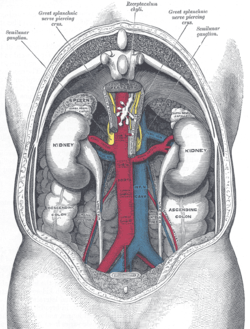Retroperitoneal space
| Retroperitoneal space | |
|---|---|
 Transverse section, showing the relations of the capsule of the kidney. (Peritoneum is labeled at center right.) | |
 Human kidneys viewed from behind with spine removed | |
| Details | |
| Identifiers | |
| Latin | spatium retroperitoneale |
| TA | A10.1.01.002 |
| FMA | 15080 |
The retroperitoneal space (retroperitoneum) is the anatomical space (sometimes a potential space) in the abdominal cavity behind (retro) the peritoneum. It has no specific delineating anatomical structures. Organs are retroperitoneal if they have peritoneum on their anterior side only. Structures that are not suspended by mesentery in the abdominal cavity and that lie between the parietal peritoneum and abdominal wall are classified as retroperitoneal.[1]
The retroperitoneum can be further subdivided into the following:[2]
- Perirenal space
- Anterior pararenal space
- Posterior pararenal space
Retroperitoneal structures
Structures that lie behind the peritoneum are termed "retroperitoneal". Organs that were once suspended within the abdominal cavity by mesentery but migrated posterior to the peritoneum during the course of embryogenesis to become retroperitoneal are considered to be secondarily retroperitoneal organs.
- Primarily retroperitoneal, meaning the structures were retroperitoneal during the entirety of development:
- urinary
- circulatory
- digestive
- Secondarily retroperitoneal, meaning the structures initially were suspended in mesentery and later migrated behind the peritoneum during development:
Subdivisions
- Perirenal Space
Bounded by the anterior and posterior leafs of the renal fascia. It contains the following structures:
- Adrenal gland
- Kidney
- Renal vessels
- Anterior pararenal space
Bounded by the posterior layer of peritoneum and the anterior leaf of the renal fascia. It contains the following structures:
- Posterior pararenal space
Bounded by the posterior leaf of the renal fascia and the muscles of the posterior abdominal wall. It contains only fat.
Clinical significance
Bleeding from a blood vessel or structure in the retroperitoneal such as the aorta or inferior vena cava into the retroperitoneal space can lead to a retroperitoneal hemorrhage.
See also
References
- ↑ Gray's Anatomy for Students, 2nd Ed. 2010. Pg. 251
- ↑ Ryan, Stephanie; McNicholas, Michelle; Eustace, Stephen (2004). Anatomy for Diagnostic Imaging. Sydney: Saunders. p. 191. ISBN 978-0-7020-2620-1.
- ↑ Kyung Won Chung (2005). Gross Anatomy (Board Review). Hagerstown, MD: Lippincott Williams & Wilkins. p. 256. ISBN 0-7817-5309-0.
- ↑ K. L. Moore; A. F. Dalley; A. M. R. Agur (2005). Clinically Oriented Anatomy. Hagerstown, MD: Lippincott Williams & Wilkins. p. 1209. ISBN 0-7817-3639-0.